1995 CHEVROLET CAMARO fuel
[x] Cancel search: fuelPage 185 of 388
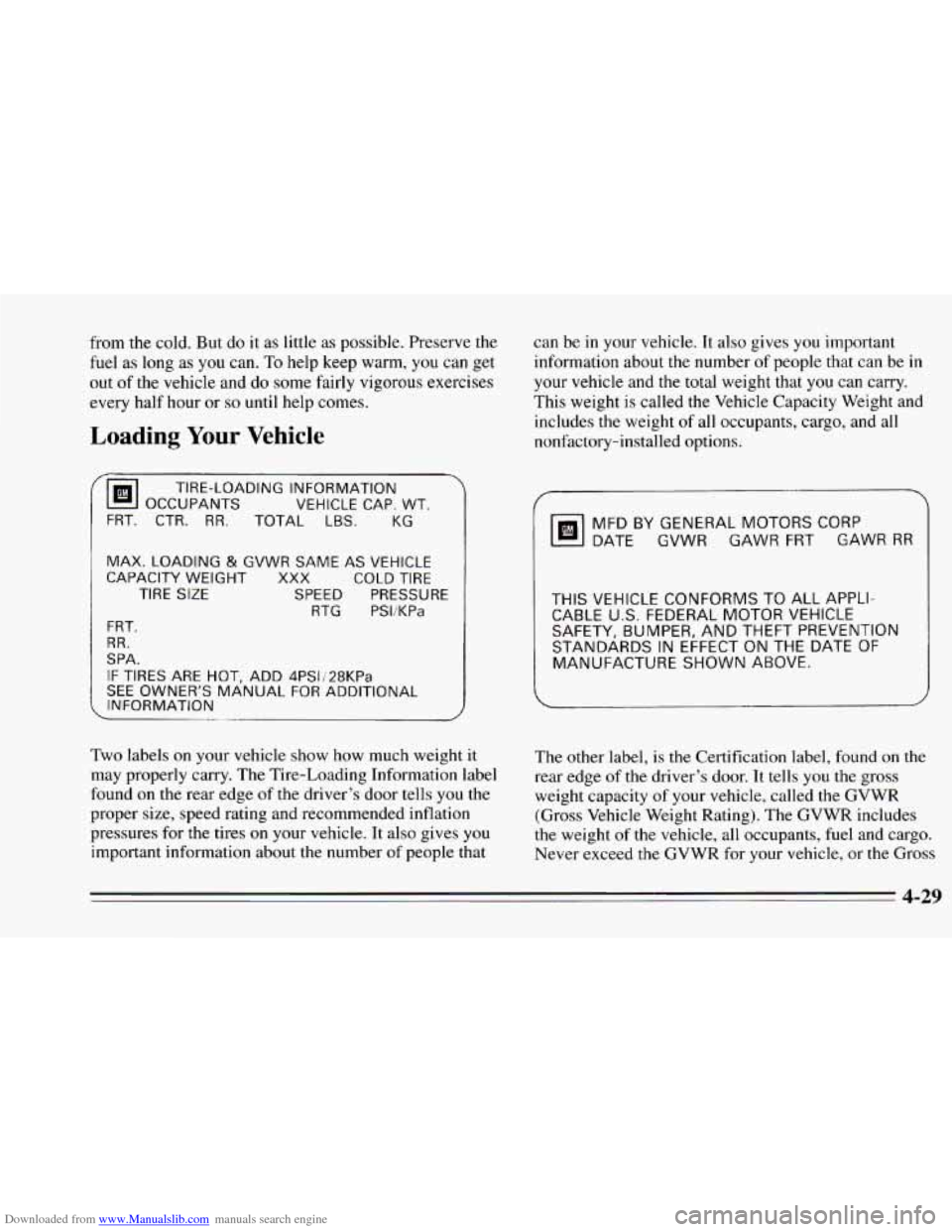
Downloaded from www.Manualslib.com manuals search engine from the cold. But do it as little as possible. Preserve the
fuel as long as you can.
To help keep warm, you can get
out
of the vehicle and do some fairly vigorous exercises
every half hour or
so until help comes.
Loading Your Vehicle
can be in your vehicle. It also gives you important
information about
the number of people that can be in
your vehicle and
the total weight that you can carry.
This weight is called the Vehicle Capacity Weight and
includes the weight of all occupants, cargo, and all
nonfactory-installed options.
OCCUPANTS
VEHICLE CAP. WT.
TIRE-LOADING INFORMATION
FRT.
CTR. RR. TOTAL LBS. KG
MAX. LOADING & GVWR SAME AS VEHICLE
CAPACITY WEIGHT XXX COLD TIRE
TIRE SIZE SPEED PRESSURE
RTG PSliKPa
FRT.
RR.
SPA.
IF TIRES ARE HOT. ADD 4PSIi28KPa
SEE OWNER‘S MANUAL FOR ADDITIONAL
INFORMATION
MFDBYGENERALMOTORSCORP
DATE GVWR GAWR FRT GAWR
RR
THIS VEHICLE CONFORMS TO ALL APPLI-
CABLE U.S. FEDERAL MOTOR VEHICLE
SAFETY, BUMPER, AND THEFT PREVENTION
STANDARDS
IN EFFECT ON THE DATE OF
MANUFACTURE SHOWN ABOVE.
Two labels on your vehicle show how much weight it
may properly carry. The Tire-Loading Information label
found
on the rear edge of the driver’s door tells you the
proper size, speed rating and recommended inflation
pressures for the tires
on your vehicle. It also gives you
important information about the number of people that The other label,
is the
Certification label, found on the
rear edge of the driver’s door. It tells you the gross
weight capacity of your vehicle, called the GVWR
(Gross Vehicle Weight Rating). The GVWR includes
the weight
of the vehicle, all occupants, fuel and cargo.
Never exceed the GVWR for your vehicle, or the Gross
4-29
Page 187 of 388
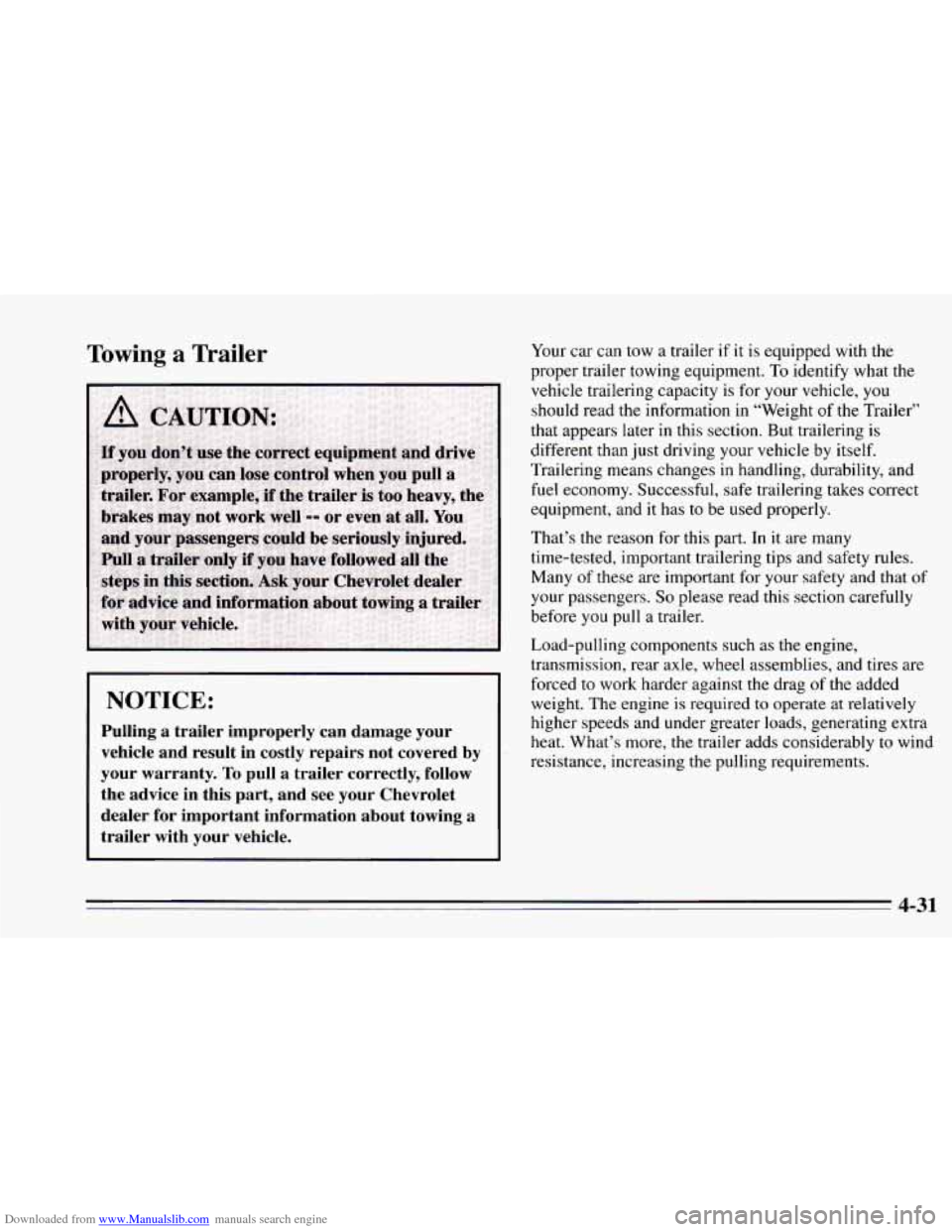
Downloaded from www.Manualslib.com manuals search engine Towing a Trailer
NOTICE:
Pulling a trailer improperly can damage your
vehicle and result in costly repairs not covered
by
your warranty. To pull a trailer correctly, follow
the advice in this part, and see your Chevrolet
dealer for important information about towing a
trailer with your vehicle.
Your car can tow a trailer if it is equipped with the
proper trailer towing equipment. To identify what the
vehicle trailering capacity is for your vehicle,
you
should read the information in “Weight of the Trailer”
that appears later
in this section. But trailering is
different than just driving your vehicle by itself.
Trailering means changes in handling, durability, and
fuel economy. Successful, safe trailering takes correct
equipment, and
it has to be used properly.
That’s the reason for this part. In
it are many
time-tested, important trailering tips and safety rules.
Many of these are important for your safety and that
of
your passengers. So please read this section carefully
before you pull a trailer.
Load-pulling components such as the engine,
transmission, rear axle, wheel assemblies, and tires are
forced to work harder against the drag
of the added
weight. The engine
is required to operate at relatively
higher speeds and under greater loads, generating extra
heat. What’s more, the trailer adds considerably
to wind
resistance, increasing the pulling requirements.
4-31
Page 233 of 388
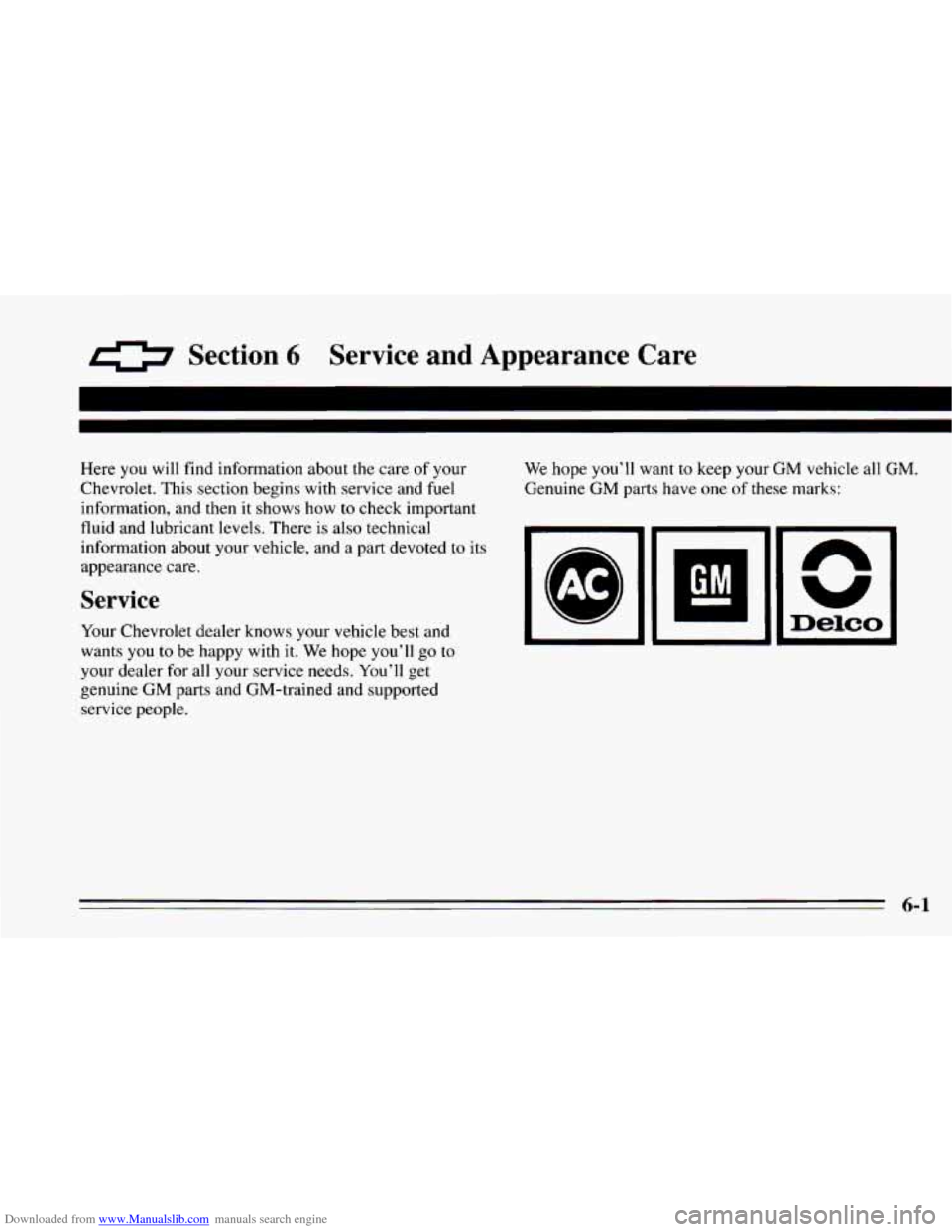
Downloaded from www.Manualslib.com manuals search engine 0 Section 6 Service and Appearance Care
Here you will find information about the care of your We hope you’ll want to keep your GM vehicle all GM.
Chevrolet. This section begins with service and fuel
Genuine GM parts have one of these marks:
information, and then it shows how to check important
fluid and lubricant
levels. There is also technical
information about your vehicle, and a part devoted to its
appearance care.
Service
Your Chevrolet dealer knows your vehicle best and
wants you
to be happy with it. We hope you’ll go to
your dealer for
all your service needs. You’ll get
genuine GM parts and GM-trained and supported
service people.
n-
Delco
6-1
Page 235 of 388
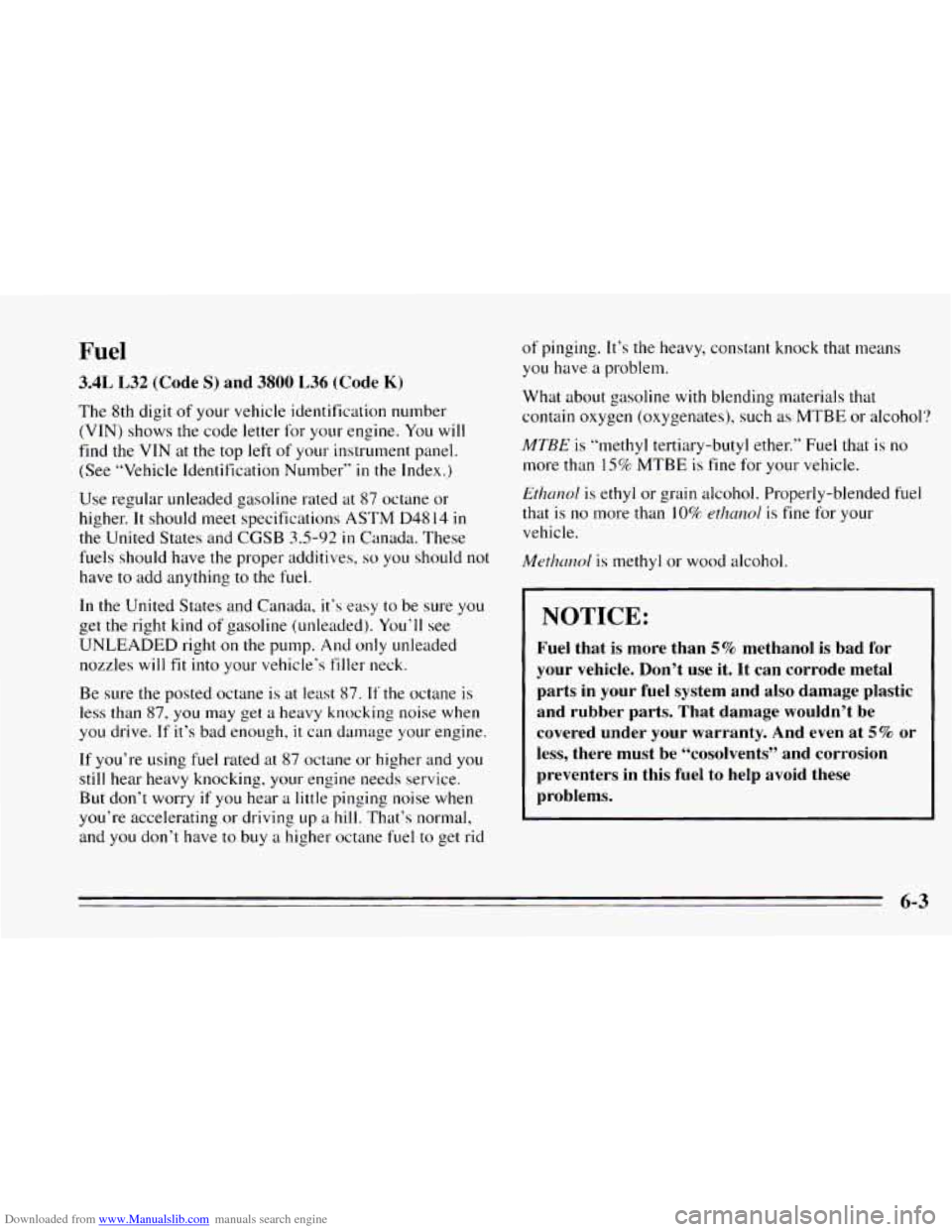
Downloaded from www.Manualslib.com manuals search engine Fuel
3.4L L32 (Code S) and 3800 L36 (Code K)
The 8th digit of your vehicl,e identification number
(VIN) shows the code letter for your engine. You will
find the
VIN at the top left of your instrument panel.
(See “Vehicle Identification Number”
in the Index.)
Use regular unleaded gasoline rated at
87 octane or
higher.
It should meet specifications ASTM D4814 in
the United States and CGSB 3.5-92 in Canada. These
fuels should have the proper additives,
so you should not
have to add anything to the fuel.
In the United States and Canada, it‘s easy to be sure you
get
the right kind of gasoline (unleaded). You’ll see
UNLEADED right on the pump, And only unleaded
nozzles will
fit into your vehicle‘s filler neck.
Be sure the posted octane is at least
87. If‘ the octane is
less than
87, you may get a heavy knocking noise when
you drive. If it’s bad enough, it can damage your engine.
If you’re using fuel rated at
87 octane or higher and you
still hear heavy knocking, your engine needs service.
But don’t worry
if you hear a little pinging noise when
you’re accelerating or driving up
a hill. That’s normal,
and
you don’t have to buy a higher octane fuel to get rid of
pinging. It’s the heavy, constant knock that means
you have a problem.
What about gasoline
with blending materials that
contain oxygen (oxygenates), such as
MTBE or alcohol?
MTBE is “methyl tertiary-butyl ether.” Fuel that is no
more than
15% MTBE is fine for your vehicle.
Etl?mol is ethyl or grain alcohol. Properly-blended fuel
that is no more than 10%
ethuuol is fine for your
vehicle.
Metlwrnof is methyl or wood alcohol.
NOTICE:
Fuel that is more than 5% methanol is bad for
your vehicle. Don’t use it.
It can corrode metal
parts in your fuel system and also damage plastic
and rubber parts. That damage wouldn’t be
covered under your warranty. And even at
5% or
less, there must be “co~oIvent~’’ and corrosion
preventers in this fuel to help avoid these
problems.
6-3
Page 236 of 388
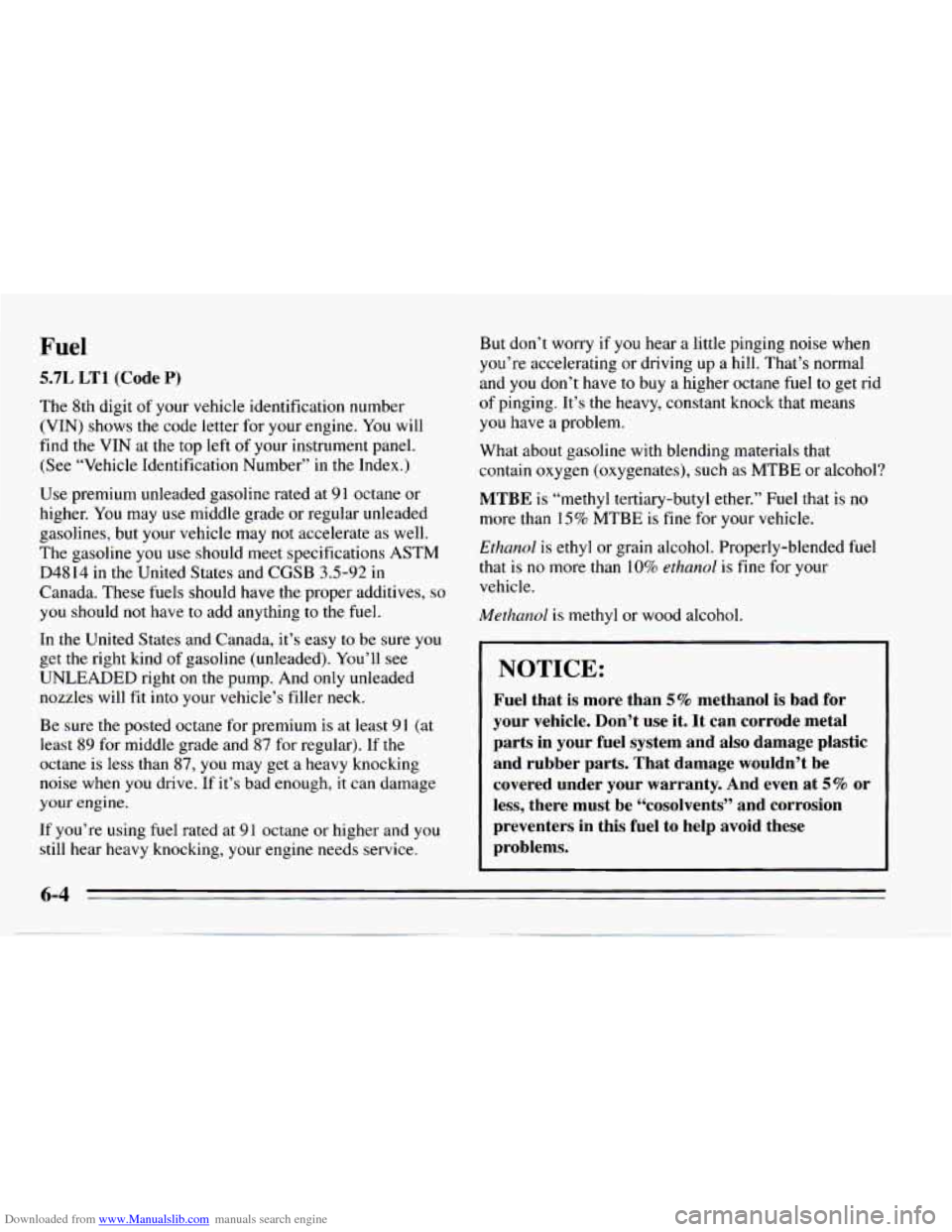
Downloaded from www.Manualslib.com manuals search engine Fuel
5.7L LT1 (Code P)
The 8th digit of your vehicle identification number
(VIN) shows the code letter for your engine.
You will
find the
VIN at the top left of your instrument panel.
(See “Vehicle Identification Number” in the Index.)
Use premium unleaded gasoline rated at
91 octane or
higher.
You may use middle grade or regular unleaded
gasolines, but your vehicle may
not accelerate as well.
The gasoline you use should meet specifications ASTM
D4814 in the United States and
CGSB 3.5-92 in
Canada. These fuels should have the proper additives,
so
you should not have to add anything to the fuel.
In the United States and Canada, it’s easy to be sure you
get the right kind of gasoline (unleaded). You’ll see
UNLEADED right on the pump. And
only unleaded
nozzles will fit into your vehicle’s filler neck.
Be sure the posted octane for premium is at least
9 I (at
least
89 for middle grade and 87 for regular). If the
octane is less than
87, you may get a heavy knocking
noise when
you drive. If it’s bad enough, it can damage
your engine.
If you’re using fuel rated at
9 1 octane or higher and you
still hear heavy knocking, your engine needs service. But don’t worry
if
you hear a little pinging noise when
you’re accelerating or driving up
a hill. That’s normal
and
you don’t have to buy a higher octane fuel to get rid
of pinging.
It’s the heavy, constant knock that means
you have a problem.
What about gasoline with blending materials that
contain oxygen (oxygenates), such as MTBE or alcohol?
MTBE is “methyl tertiary-butyl ether.’’ Fuel that is no
more than 15% MTBE is fine for your vehicle.
Ethanol is ethyl or grain alcohol. Properly-blended fuel
that
is no more than 10% ethanol is fine for your
vehicle.
Methanol is methyl or wood alcohol.
I NOTICE:
Fuel that is more than 5% methanol is bad for
your vehicle. Don’t use it. It can corrode metal parts in your fuel system and also damage plastic
and rubber parts. That damage wouldn’t be
covered under your warranty. And even at
5% or
less, there must be “cosolvents” and corrosion
preventers in this fuel to help avoid these
problems.
6-4
Page 237 of 388

Downloaded from www.Manualslib.com manuals search engine Gasolines for Cleaner Air
Your use of gasoline with deposit control additives will
help prevent deposits from forming
in your engine and
fuel system. That helps keep your engine in tune and
your emission control system working properly. It’s
good for your vehicle, and you’ll be doing your part for
cleaner air.
Many gasolines are now blended with oxygenates.
General Motors recommends that you use gasolines with
these blending materials, such as MTBE and ethanol. By
doing
so, you can help clean the air, especially in those
parts of the country that have high carbon monoxide
levels.
In addition, some gasoline suppliers are now producing
reformulated gasolines. These gasolines are specially
designed
to reduce vehicle emissions. General Motors
recommends that you use reformulated gasoline. By
doing
so, you can help clean the air, especially in those
parts
of the country that have high ozone levels.
You should ask your service station operators if their
gasolines contain deposit control additives and oxygenates, and
if they have been reformulated to
reduce vehicle emissions.
Fuels in Foreign Countries
If you plan on driving in another country outside the
U.S. or Canada, unleaded fuel may be hard to find. Do
not use leaded gasoline. If you use even one tankful,
your emission controls won’t work well or at all. With
continuous
use, spark plugs can get fouled, the exhaust
system can corrode, and your engine oil can deteriorate
quickly. Your vehicle’s oxygen sensor will be damaged.
All of that means costly repairs that wouldn’t be covered
by your warranty.
To check on fuel availability, ask an auto club, or
contact a major oil company that does business in the
country where you’ll be driving.
You can also write us at the following address for
advice. Just tell us where you’re going and give your
Vehicle Identification Number (VIN).
General Motors Overseas Distribution Corporation
North American Export Sales (NAES)
1908 Colonel Sam Drive
Oshawa, Ontario
L1H 8P7
6-5
Page 238 of 388
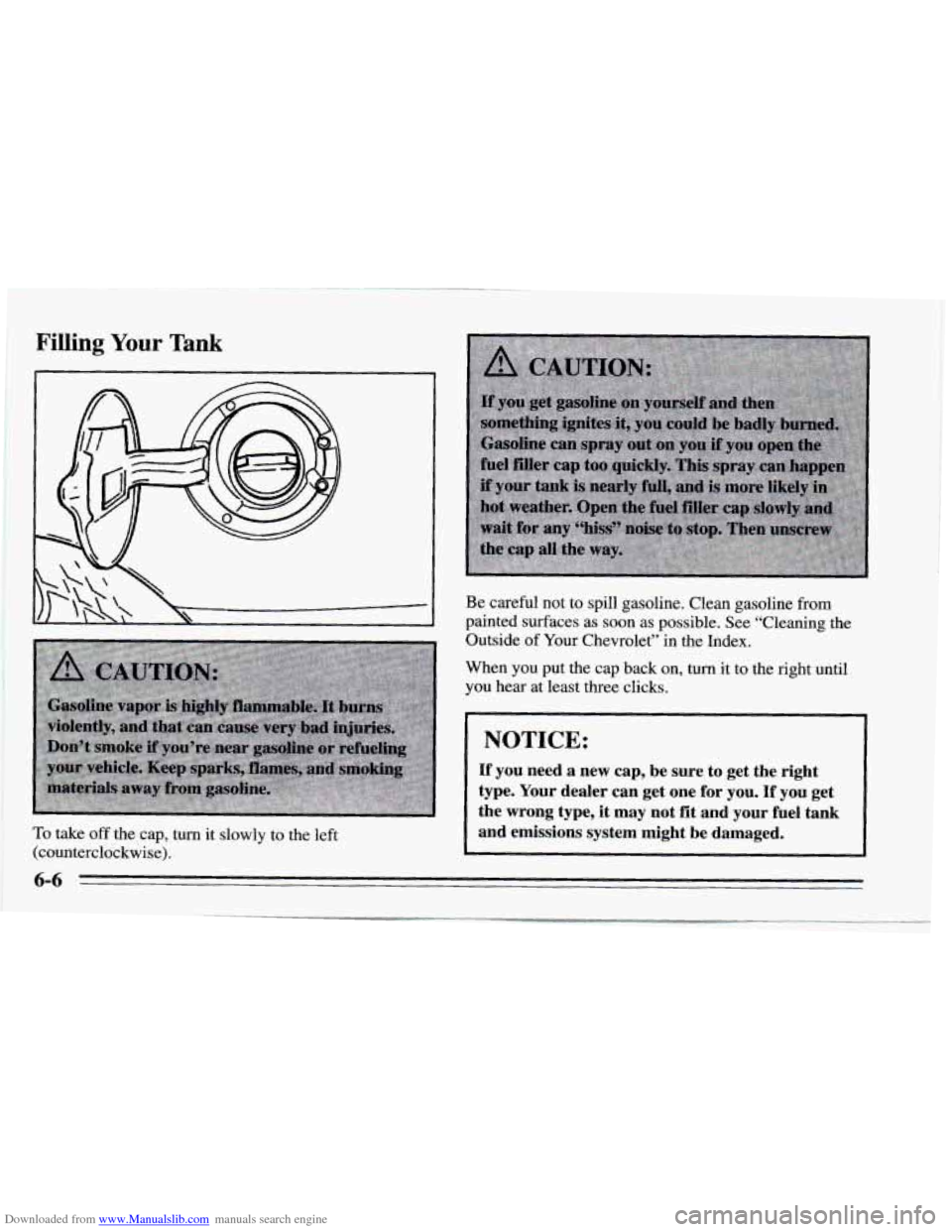
Downloaded from www.Manualslib.com manuals search engine Filling Your Tank
To take off the cap, turn it slowly to the left
(counterclockwise). Be careful not
to spill gasoline. Clean gasoline from
painted surfaces as soon as possible. See “Cleaning
the
Outside of Your Chevrolet” in the Index.
When
you put the cap back on, turn it to the right until
you hear at least three clicks.
NOTICE:
If you need a new cap, be sure to get the right
type. Your dealer can get one for you.
If you get
the wrong type, it may not fit and your fuel tank and emissions system might be damaged.
6-6
Page 243 of 388
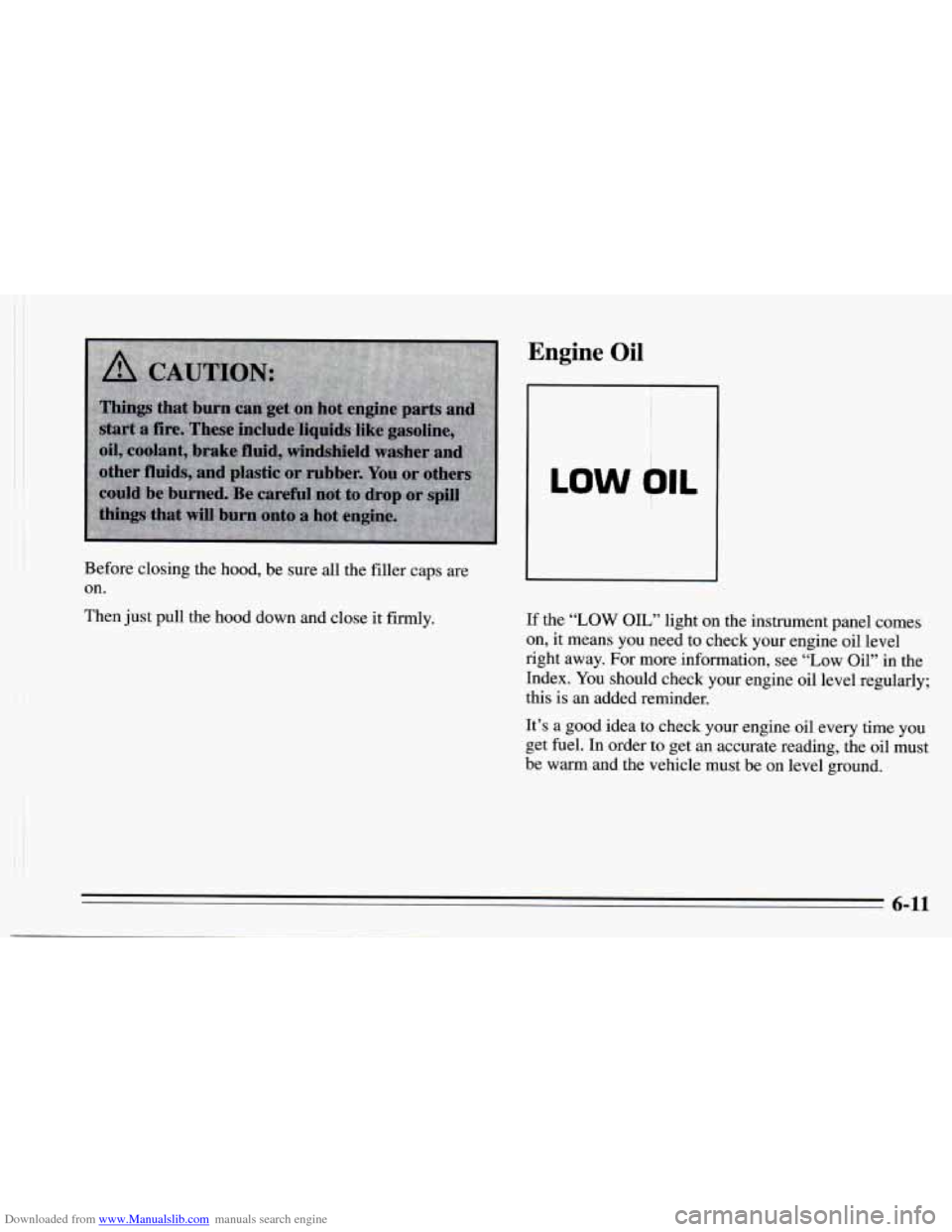
Downloaded from www.Manualslib.com manuals search engine Then just pull the hood down and close it firmly.
Before closing
the hood, be sure
all the filler caps are
on.
Engine Oil
LOW blL
If the “LOW OIL” light on the instrument panel comes
on, it means you need to check your engine oil level
right away. For more information, see “Low Oil”
in the
Index. You should check your engine oil level regularly;
this is an added reminder.
It’s
a good idea to check your engine oil every time you
get
fuel. In order to get an accurate reading, the oil must
be warm and the vehicle must be on level ground.
6-11